

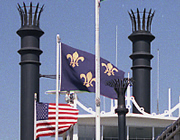
A wonderfully vibrant city famous for its fine food and music; the contrasting peace and antebellum charm of the beautiful Plantation Houses.
Steamboats and swamps, beaches and bayous - even a battlefield, and always not far away the great Mississippi River.
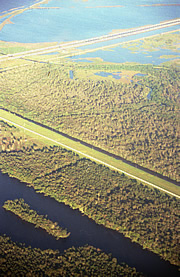
This was our first real visit to the south. We didn't really go into the more modern parts of the city, sticking to the French Quarter of New Orleans. We'd wanted to visit the unique cemeteries with their above-ground tombs (due to the high water table) but had been told it wasn't safe. But we loved New Orleans (it must be great at Mardi Gras) and the quiet contrast of the beautiful plantation houses along the Mississippi - even the swamps are fascinating!
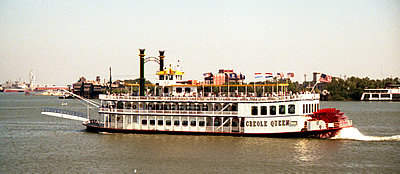
New Orleans was founded by the French on the banks of the 2300 mile long Mississippi in 1718 - on the Gulf of Mexico it is a perfect location for a port city. Louisiana itself is named after Louis XIV of France. It experienced rapid growth servicing the Spanish, French and British ships which came to trade their fine wines, cloths, foods and other goods for the timber, tobacco and animal hides coming down the Mississippi.
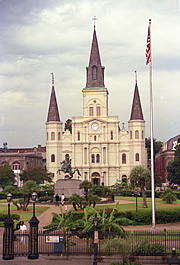
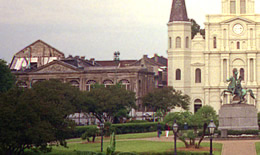
In 1754 the French and British went to war over lands in North America - the British won and in 1763 gained all French lands east of the Mississippi. However, in 1762, New Orleans and Louisiana lands to the west of the Mississippi had been given to the Spanish - King Carlos III was the cousin of King Louis XV and Carlos was keen to keep Louisiana as a buffer between his own lands and the British!
Louisiana supported the rebels against the British in the American War of Independence (1775–1783) and offered sanctuary to refugees, beginning a tradition of welcoming immigrants, including Canadian Acadians whose descendants are the celebrated Cajuns of Louisiana.
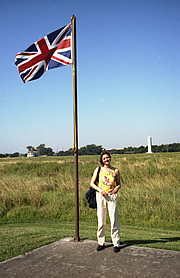
A major change to New Orleans and the rest of Louisiana came in 1800 when Napoleon forced the Spanish to return the colony to French rule - of some concern to President Jefferson because of the strategic importance of New Orleans at the mouth of the Mississippi. He tried to buy the city from Napoleon who responded by offering the whole of Louisiana - he was badly in need of money to finance wars against the British. Thus it was that on April 29th, 1803 Louisiana was sold for $15 million, the deal being completed in the Cabildo next to St Louis Cathedral.
1812 was another momentous year when Louisiana achieved statehood. The United States was at war with the British and for Louisiana this ended with the Battle of New Orleans, when troops led by General Andrew Jackson defeated the British at Chalmette (though a treaty ending the
In the early part of the nineteenth century the tradition of Mardi Gras grew up. A long-established European event was given a typically New Orleans twist with exuberant carnival parades.
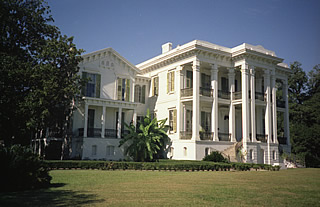
The Antebellum period (before the American Civil War 1861–1865 ) was a boom time for Louisiana. The invention of the cotton gin by Eli Whitney at the end of the eighteenth century had at last made growing cotton a profitable business. Prior to this, separation of the cotton from its sticky seeds had been a highly labour-intensive process. Cotton was king, with sugar also a major crop, and the plantations prospered. Slave labour not only picked the cotton and cut the cane, but often grew all the food needed on the larger plantations.
On January 26th, 1861 Louisiana seceded from the Union and less than three months later southern troops attacked Fort Sumter in Charleston. By the end of April 1862, however, New Orleans had been retaken by Union forces. The town was under reconstruction for almost 15 years during which time Louisiana was readmitted to the Union in 1868, one of the conditions of re-entry being the renouncement of slavery.
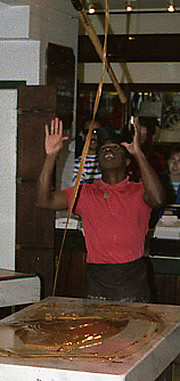
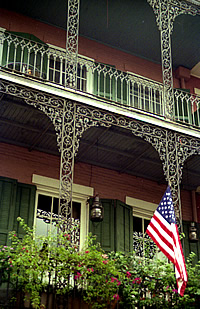
Also known as the Vieux Carré, this is the oldest part of the city, where it all began in 1718. Most of the quarter was rebuilt in the late 1790s onwards after fires destroyed most of the earlier buildings. Most distinctive is the beautiful ironwork. This is a great place just to dump the guidebook and wander around - lots of street artists and especially music to entertain along the way.
It's layout is a classical grid of streets and surrounds Jackson Square close to the river. The square has two of the most historically important buildings in the city: St Louis Cathedral, completed in 1794 with major works fifty years later, and the Cabildo, completed in 1799 to be the seat of government in the city, now the Louisiana State Museum - sadly without its third floor when we visited due to a major fire in May.
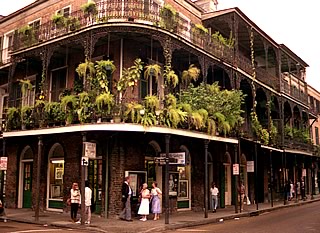
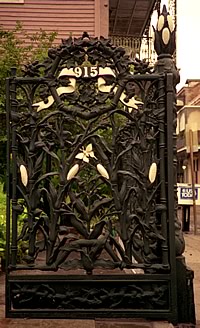
The Jackson Brewery has been converted into a complex of shops, restaurants, galleries, etc. and is fun to walk around - the fudge-making is especially impressive! Nearby the old French Market has been converted into another such complex which is rather a shame - traditional markets are often fascinating and colourful places.
American Jazz began here in New Orleans: a fusion of many influences but mainly African-American vocal and percussive effects combined with European instruments. We didn't go into any music venues to listen to traditional New Orleans jazz (there's hardly a need to!), apart from Preservation Hall which was certainly belting out the Dixieland.
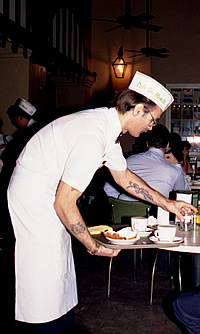
Plus there are a million places to eat and drink. Food is celebrated here, from the humble "po' boy" and muffuletta sandwiches (excellent!) to all kinds of interesting dishes - gumbo, seafood, Creole creations. We tried Cajun at the Olde N'Awlins Cookery where I had Jambalaya - a great place.
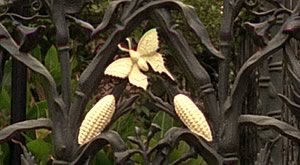
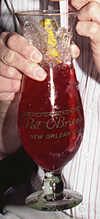

Apart from all this, two institutions which are an absolute must are Pat O'Brien's and the Café du Monde. The former is a bit touristy but the latter seems to be popular as much with the locals.
Pat O'Brien's dates from December 3rd, 1933. Originally on the corner of St. Peter and Royal, after a couple of moves it can now be found at at 718 St. Peter. Pat O'Brien's does drinks with a vengeance. It boasts the largest volume of business of any drink establishment in the world. The courtyard is a great place with its fire fountains and everybody having fun ( an O'Brien's dictum!). The house drink, really a must, is the Hurricane - brilliant!
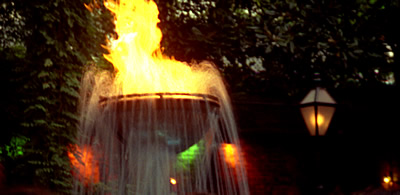
The Café du Monde is at the other end of the evening, so to speak. Established in 1862 in the French Market on Decatur Street , it is the place to sit and watch the world go by with café au lait and fabulous beignets - square French-style doughnuts, covered with powdered sugar - impossible to resist.

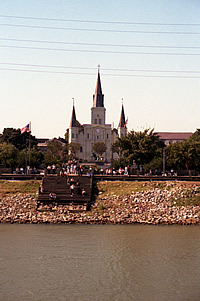
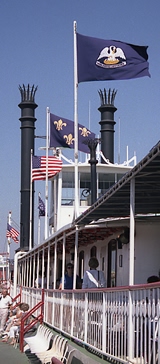
Some things you just have to do and this seemed to be one of them! The very first steamboat, the New Orleans, arrived here in 1812.
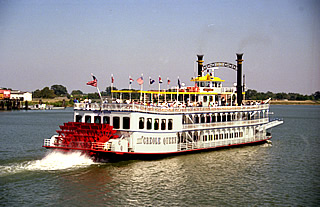
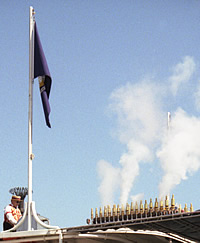
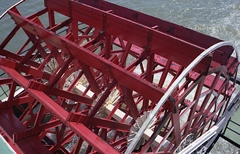
The Natchez is famous for having a steam calliope on board - a very loud whistle-based instrument.
Quite a pleasant way to spend a couple of hours, seeing the city from the river, but the main attraction is the boat itself.
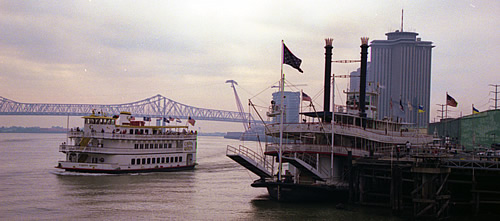
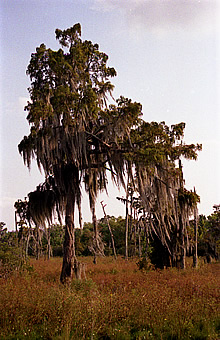
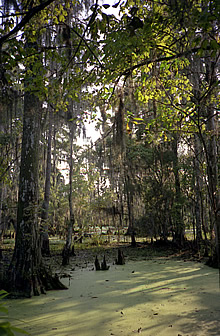
Bayou Barataria is about ten miles south-west of New Orleans and borders Lake Salvador. It is one of the three units of the Lafitte National Historic Park, the other two being the French Quarter and Chalmette. Jan Lafitte lived in New Orleans from 1803 to 1820. He seems to have been a bit of a pirate but gained hero status from supplying arms and troops against the British.
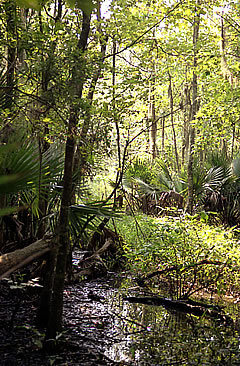

The boardwalk hiking trails are great for getting into this area. The huge live oaks hung with Spanish Moss are very atmospheric - not so keen on the huge spider webs strung above - with resident spiders!
An alligator basking on a rock at the edge of the water seemed to be looking straight at us!

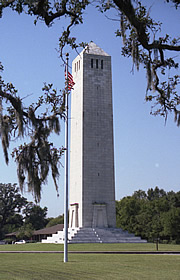
Until the end of the Napoleonic wars in 1814 England had been unable to send many troops to the war in America. By January 14th 1815, however, General Jackson found himself facing thousands of battle-hardened soldiers. His victory against such a superior force was justly regarded with great pride by the American people.
The battlefield site of the Battle of New Orleans lies six miles to the east of New Orleans. This was Chalmette plantation, though Beauregard House, which was built here in 1833, was never a plantation house, being simply a country residence.
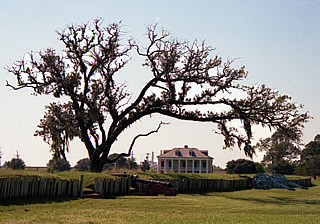
A levee separates the battlefield from the Mississippi and an imposing monument rises from the battlefield to honour the victory.
The Visitor Centre, housed in Beauregard House, has an explanation of the battle, and a leaflet includes a trail map and very good description of interesting points on the battlefield. There is an excellent view of the Mississippi and New Orleans from the levee behind Beauregard House.
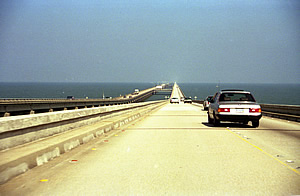
New Orleans lies on the south shore of Lake Pontchartrain which was named after the Count de Pontchartrain, a minister of Louis XIV of France. It is a vast expanse of water - very calm on the day we were there.
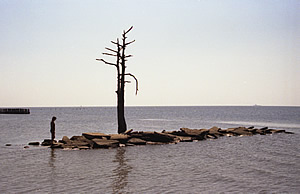
The causeway across the lake is remarkable - the longest bridge over water in the world at almost 24 miles. It consists of a double parallel span, each span being used to drive in one direction only.
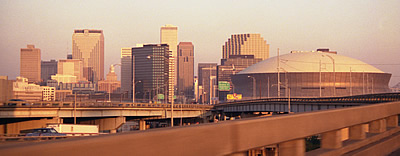
We drove across the causeway to spend a very pleasant afternoon relaxing on the north shore. The north lakeshore is very peaceful and the lake is good to swim in - it certainly looks very clean.
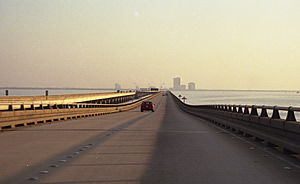
In the evening sunset the Business District Skyline was lit up as we recrossed the causeway back to New Orleans. This was about as close as we got to this part of the city.

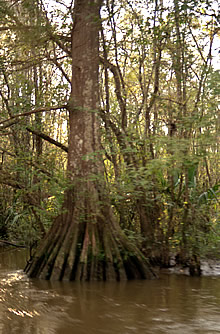
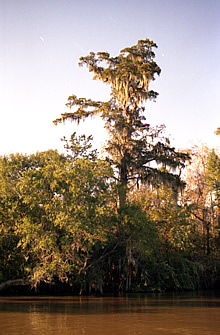
Back to the swamps, and this was a great little trip, again into landscape which was very alien to us. It was a late afternoon departure from Indian Village Landing near Slidell on the north shore of Lake Pontchartrain, in a peculiar flat boat, very low in the water.
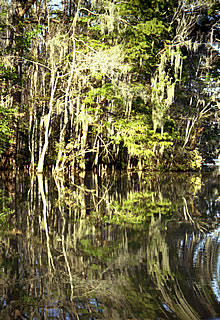
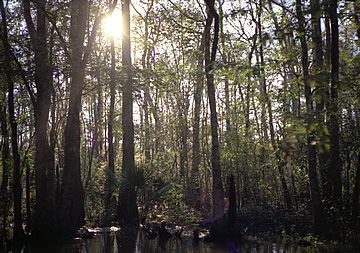
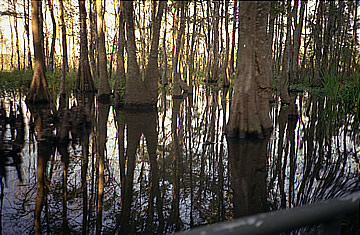
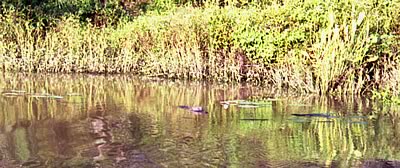
The tour, deep into the Honey Island cypress swamp, lasted about two hours and we saw alligator, diamond-back snakes, small turtle, a Bald Eagle nesting, immature white ibis, Banana Spiders (!) and a Great Blue Heron in flight.
The swamp itself can be quite atmospherically creepy - it's so still and quiet, apart form the guide who is indispensable in spotting the wildlife and explaining the vegetation. Would certainly recommend this experience for those, like us, with little or no knowledge of swamps.
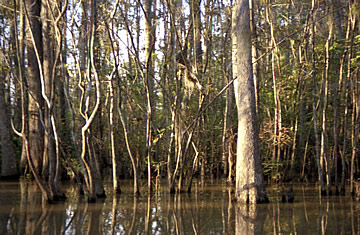
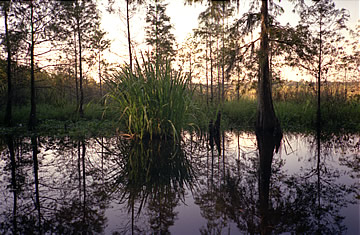

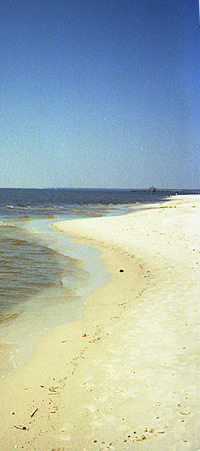
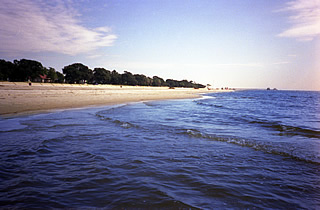
We drove about 60 miles north east from New Orleans into Mississippi to spend a day on the Gulf shore at Biloxi.
Beautiful, almost-deserted, white sandy beaches, fine weather and a waterfront restaurant for a great lunch - Fisherman's Wharf - made for a perfect day away from the city.
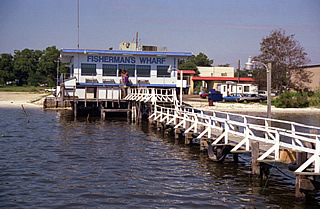
For seventy miles between New Orleans and Baton Rouge, the Great River Road was lined with sugar plantations, the magnificent Greek Revivalist houses of the wealthy owners and the slave villages of the workers. These gracious buildings are generally white and pillared and often of recognisably Greek Style. The main alternative style for Plantation Houses was Creole - more ornate and colourful than the Greek Revivalist. Generally two or three storeys, they always had balconies or a veranda on the first floor (second floor in U.S.A-speak ) and sometimes ingenious systems for ventilation - a system of louvers on the attic floor of San Francisco, deep verandas to keep the house in shade, opposing doors and windows for cross-ventilation. Living quarters were generally above the ground floor - before levees were built flooding was a regular hazard. Several of the houses have been sympathetically restored to their former splendour and can be visited almost all year round. We restricted ourselves to three on the Great River Road plus Madewood a little further afield.
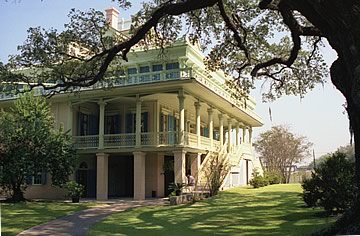
This beautiful house was the exception to the Greek Revivalist architecture that we saw elsewhere, being Creole or "steamboat gothic" in style. It's name apparently is derived from the slang "sans fruscins" meaning "without a penny" - presumably because it nearly bankrupted the original owner!
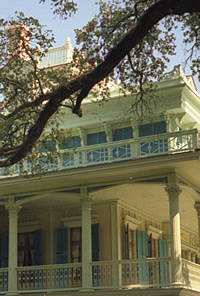
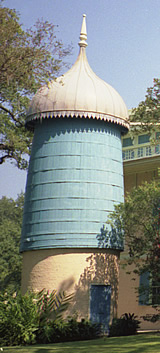
Edmond Bozonie Marmillion purchased the plantation in 1830 and built this house in the mid-1850s. Unfortunately Marmillion had little time to enjoy his home as he died in 1856 and the house and plantation passed to his son Valsin. The decoration inside is thought to reflect the influence of Valsin's wife, Louise von Seybold, who was Bavarian.
The house has been restored to the era of its prosperity before the Civil War and hence in the style of the Marmillion's building and decoration.
The ground floor has mostly service rooms: pantry, food storage and a wine cellar. Water was piped into the house from two decorative but functional water tanks - one on each side of the building. The interior is decorated with painted ceilings and marbling and furniture of the period and felt quite cool.
A very elegant symmetric double staircase rises from the ground to the first floor on the front of the building. Living quarters are on the first floor with an ingenious louvered roof space for ventilation. The veranda on the first floor is supported by Corinthian columns.
San Francisco Plantation House is quite different from the other houses we saw and we liked it very much, in particular its colourful and slightly ornate exterior.
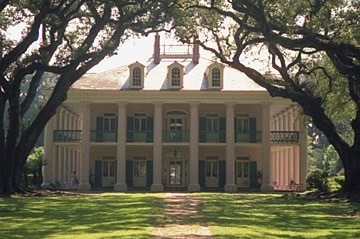
In the early 1700s a small house existed on this site and it was at this time that the broad avenue of twenty-eight live oaks was planted. "Live Oaks" are oaks which are evergreen.
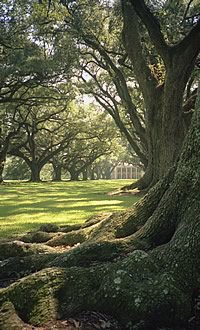
In 1836 the sugar plantation was bought by Jacques Telesphore who commissioned an architect to design a new Greek Revivalist home for himself and his wife. Oak Alley took five years to complete and no expense was spared to create a fashionable house. Although Oak Alley survived the Civil War intact, thereafter it was sold through a succession of owners. In 1925 the house was in poor condition when purchased by Andrew and Josephine Stewart who began the long period of restoration. Oak Alley was the first River Road plantation to be fully restored to its former glory.
Inside, as always with the plantation homes, the design took care to provide maximum ventilation. I was very impressed by a most ingenious system of interior doors which can be opened to allow for cross ventilation or for hot air to rise up and out through the central belvedere on the roof, the tall windows and doors facing each other to maximise the effect. The deep veranda is a common feature of plantation homes and provides good shade, especially through the hottest part of a summer day.
The aspect of the house through the avenue of oaks is magnificent and I would imagine difficult to beat by any plantation home. The twenty-eight double height classical Doric columns which surround the building are a traditional plantation-style Greek Revivalist feature which, in this case, neatly mirror in number the avenue of oaks.

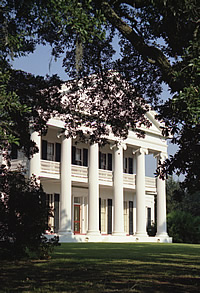
Further south near Napoleonville stands this 1846 Greek revival mansion which has been restored to its antebellum splendour. This house is unusual in that it remains a family home. It lies on Bayou Lafourche - over a hundred miles of meandering waterway stretching from the Mississippi to the Gulf Coast.
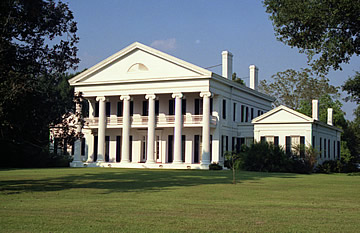
It was built in the 1840s to a more than usually pure classical design on the frontage, the fluted columns rising to a pediment very reminiscent of an ancient Greek temple. The six double height columns on the front elevation of the house are Ionic - the third classical type along with Doric (the simplest) and Corinthian (the most ornate) as seen in Oak Alley and San Francisco respectively. Two symmetric, smaller wings echo the architectural features of the main building.
It is a restrained, elegant building, in a peaceful setting, dazzling in the bright sun.
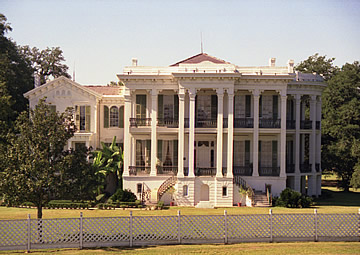
Back on the Great River Road we came to our final visit - the largest plantation home in the south: Nottoway. Huge and magnificent this is an extremely impressive building standing among magnolias and oaks dripping with Spanish moss. Designed in 1849 by Henry Howard, the architect who also designed Madewood, it was completed ten years later in 1859 in mainly Italianate style. This was the one plantation house whose interior impressed almost as much as the exterior, the only one approaching the fictional plantation houses of the movies. The 65 foot White Ballroom was the most impressive room we saw.
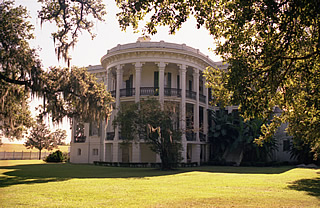
Standing just 200 feet behind the levee of the Mississippi River, this house is not as restrained as some of the smaller plantation houses. The exterior is imposing and leaves the visitor in no doubt as to the wealth of the owner. Howard's design is not symmetrical, and in this departs from the Greek classical tradition. The deep semi-circular portico to one side of the main entrance embraces the bay of the White Ballroom but is not mirrored by another on the opposite side. In addition it does not have an all-encompassing veranda and its elegant Corinthian columns, made from cypress, are square in cross-section. But the whole effect is magnificent and a high note on which to end our trip.

Since our visit to Louisiana in 1988 the Gulf Coast, including New Orleans, was severely battered by Hurricane Katrina in 2005. We were travelling in the States at the time and were able to watch the progress of events, especially the terrible inundation of New Orleans and felt strongly for the inhabitants. We wish all those in the area well, and know that the indomitable spirit of the south will prevail.
Because of this event some of the information on this page may be invalid. I've included below some links, both for added information on aspects of the page as well as current flood damage status - no responsibility is taken for the content of external websites.
Towards Racial Equality: Harpers Weekly Reports - Reconstruction Timeline